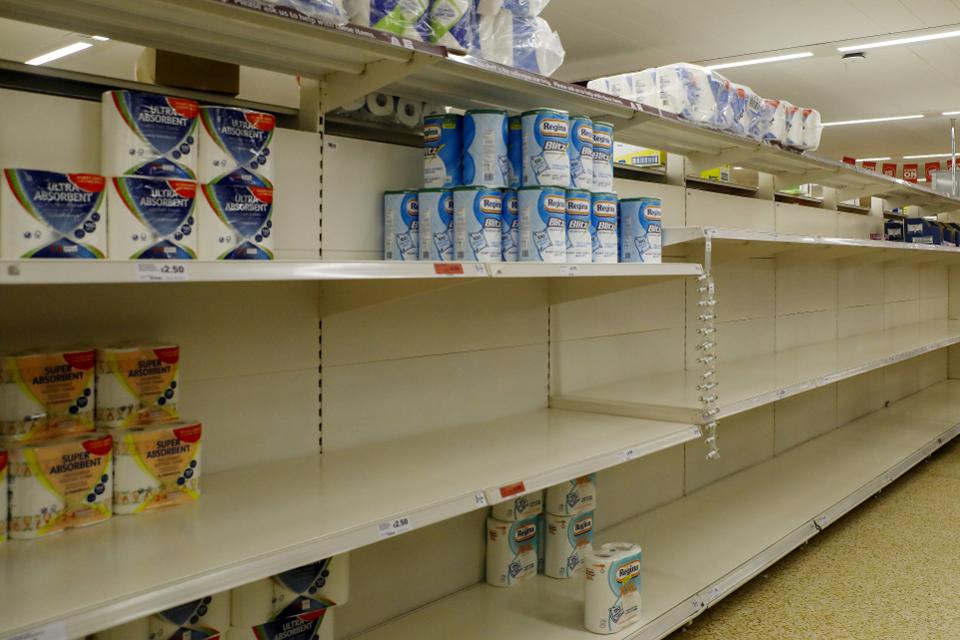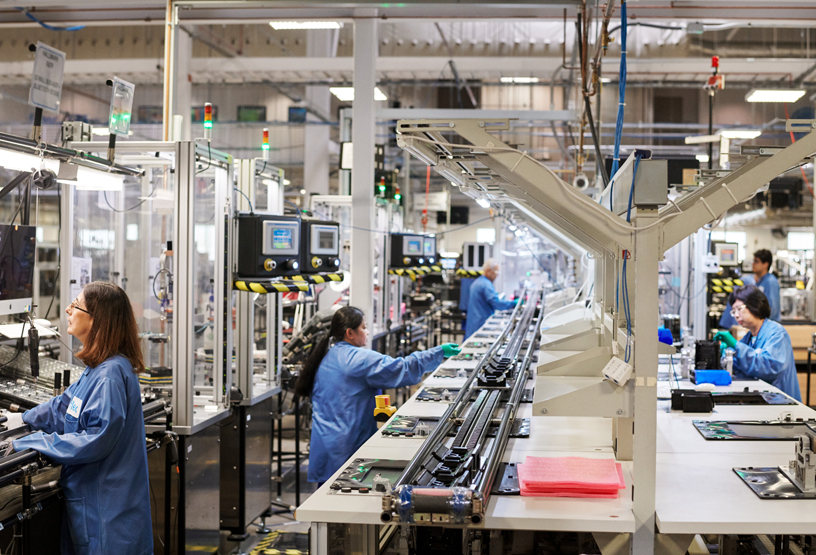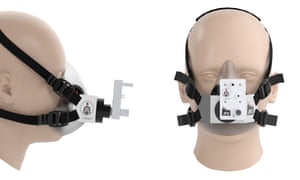
These are extraordinary times!
COVID19 has shown the world that we are as vulnerable as ever and the might of globalisation can in turn be our downfall.
Pandemic reporting internationally has turned the rhetoric of “supply chain/s” into a household phrase;
This current crisis is the quintessential example of the impact of supply chain disruption, that impact being rapid and global.
The effects are very real and compounded by the complexity of today’s global, inter-connected supply chains.

Empty shelves stand in the toilet paper aisle at a J Sainsbury Plc supermarket in Exeter, U.K., on … [+]
Toilet paper rarely makes headlines. No other commercial product save hand sanitiser and face masks have been more emblematic of coronavirus-inflicted global anxiety. Who would ever have imagined we would be fighting over the availability of the meagre little toilet roll? No other product so starkly highlights the different supply chain issues arising due to the current health crisis. After all, most experts agree that the rush to hoard toilet paper stems from an illogical anxiety. Remembering the days of ration books and quarantine our parents and grandparents will be laughing in their places or rest! I am sure the French with the bidets have wondered what all the fuss is about.
Food Supply Chain Coming into the COVID-19 Crosshairs
Grain markets this morning are mixed as disruptions in the global food supply chain challenge Plant 2020 headlines for attention from traders. Winter wheat prices are leading the complex as cooler temperatures in the Southern Plains could negatively impact a crop that’s just starting to get growing again. Outside markets are mostly higher as investors cheer on the net-new number of COVID-19 cases AND with deaths starting to slow, including in some of the worst-hit European countries, Spain, Italy, and France. As a reminder, this trading week is shortened as markets are closed on Friday in observance of Easter Good Friday!
What will happen to our hot cross buns? In New Zealand we already have a shortage of flour! The lockdown has taken us back to our grandparents days of home baking and the do it yourself (make it yourself) number 8 wire culture that home isolation has presented.
How quickly can we change the supply chain or remove the reliance of long distance supply lines by bringing it back on shore?
Coronavirus: White House rejects bipartisan bills to bring US medical supply chain back home
US Treasury Secretary Steven Mnuchin rejected the idea of using legislation to compel US medical supply companies to bring their manufacturing operations back home so Americans are less reliant on foreign countries for medical equipment during the coronavirus pandemic and future health crises.
Major disruption: How Covid-19 is affecting supply chains worldwide

With entire nations coming to a standstill to curb the rapid spread of the coronavirus, it will soon take its toll on supply chains around the world. The disrupted network of companies, factories and manufacturers could greatly affect the products we take for granted. Tech products, equipment, fashion, cars and other products are likely to have a stunted year ahead.
These are just a few snippets of news that we are exposed too currently on a daily basis constantly front and centre.
There is some COVID19 News out there that is also quite inspiring! Once again this highlights the way that we as human beings can adapt under a crisis;
Mercedes F1 team
The designs of a new breathing aid developed by engineers at the Mercedes F1 team, University College London (UCL), and clinicians at UCL Hospital have been made freely available to support the global response to Covid-19. It’s the latest development in Formula 1’s Project Pitlane effort to help fight coronavirus
Cumbrian oil services firm ‘ready to make 2,000 ventilators a week

A Cumbria-based offshore oil and gas services company has said it is ready to produce 2,000 ventilators a week to join the national effort to produce tens of thousands of machines to treat coronavirus patients.
James Fisher & Sons said it had sent a base model of its non-invasive InVicto system to the UK’s Medicines and Healthcare products Regulatory Agency (MHRA) for testing. If approved, the company said it could produce 2,000 a week.
The James Fisher ventilators are not designed for intensive care use, but the company said they can be used to relieve pressure on ICU beds by providing breathing support in “pre-critical temporary wards or care homes”
Head-lice drug gives scientist hope in fight against Covid-19
A cheap, widely used anti-parasite medication used to treat head lice killed Covid-19 cells in a petri dish and Aussie researchers hope to start human trials in a month.
Dr Kylie Wagstaff from the Biomedicine Discovery Institute at Monash University who carried out the study found Ivermectin began to kill Sars-COV-2 cells that cause Covid-19 in a petri dish within 24 hours.
Within 48 hours “we could prevent all replication of the virus in the cells,’ she said.
The study has been published online in the journal Antiviral Research.
Because the drug is already safely used in humans to treat parasites like head lice, River Blindness and scabies, it won’t be necessary to undertake lengthy animal studies and human clinical trials can be fast tracked on Covid-19 patients
James Dyson Designed a Ventilator in 10 days. Now He’s Making 15,000 to Fight Covid-19
The billionaire’s eponymous company plans to make 10,000 devices for the UK and 5,000 for international donation.

In an effort to combat the fast-moving spread of coronavirus, brands from every industry and country are pitching in to help. In France, LVMH is making hand sanitizer; in Italy, Gucci is making face masks; and, in the UK, Dyson is now making ventilators.
Best known for its vacuum cleaners and high-end fans, the British home electronics giant‘s founder, Sir James Dyson, said he has designed a new ventilator that can help ease shortages in his home country, according to CNN. The company now intends to produce 10,000 devices for the country’s National Health Service over the next month.
NZ volunteers pitch in to make thousands of face shields
This COVID business brings out the worst and best in people. Yesterday we saw the worst, today the best. The generosity of strangers: 3D printers have started printing free face shields for front-line medical practices, as there is a world-wide shortage, and they are being reserved for hospital use (We had none)
We indicated that we would be interested last night and at 10am this bloke walks in with a box full. This is going viral all over the world, with 3D printers rising …


What is VUCA (Volatility, Uncertainty, Complexity and Ambiguity) and why is it important after COVID19?
For Procurement and Supply Chain Professionals VUCA has been used as a set of guiding principles when building Strategic Category plans and Sourcing Strategies for goods and services.
VUCA is an acronym – first used in 1987, drawing on the leadership theories of Warren Bennis and Burt Nanus – to describe or to reflect on the volatility, uncertainty, complexity and ambiguity of general conditions and situations.
All mature Procurement and Supply Chain Teams will be managing their supply of goods and services strategically taking into consideration the risk associated with VUCA. When building Strategic Sourcing Strategies the risk analysis tool along with SWOT, PESTLE should be consideration under the VUCA environment. Post wars, ISIS, SARS and so on many organisations have planned for similar future eventualities and ploughed billions of dollars into prevention or defence. However, over the past few years I believe we have either become complacent, not truly understanding potential risk and threats, side tracked by other events, been driven too much around cost out, or simply not listened to key business people such as Bill Gates ( 2015 The next outbreak we are not ready TED talk).
As procurement and Supply Chain Professionals LEAN supply chains have been our operating mantra. This alongside soul sourcing and aggregation (benefit to drive cost out) has led big contracts with single companies.
Malcolm Harrison Group CEO of the Chartered Institute of Procurement and Supply aptly articulated in a recently in Supply Management “Long, lean supply chains that rely on sole sourcing strategies are a cost -effective solution – until something goes wrong”
“The over – reliance on China’s supply chains is leaving procurement and supply chain professionals in a vulnerable position”
Home many of your supply chains are single source? How are your business continuity plans for a pandemic? What will you do differently post COVID-19?
These are all critical questions which I’m sure many of you and your organisations are discussing right now. Single sourcing strategies are putting you at risk. How many of those suppliers are monopolies? If so, how much leverage do you really have?
I hope this provides you with some food for thought. Resilience will come with non-reliance on LEAN supply chains and single sourcing.
So what’s next?
There are already many publications about supply chains and COVID-19
Supply chains have been upended. Here’s how to make them more resilient – World Economic Forum
In the wake of supply chain disruptions due to coronavirus, several experts have reiterated the need to obtain more visibility across the chain. Companies who sell finished goods generally know production and shipment schedules for their Tier 1 suppliers, but they usually have little to no knowledge of suppliers further up the chain.
Obtaining this visibility is considered key to optimizing supply chain efficiency and agility during normal production. When critical supply chain disruptions hit, this visibility becomes crucial to understanding the impact of the disruption on the rest of the chain so that others in the ecosystem can plan and take action, such as developing routes to alternative suppliers.
Because COVID-19 has led to lockdowns, suppliers in the chain are temporarily ceasing production, and logistics providers can no longer transport goods as seamlessly, particularly across borders.
How can we be better prepared for a future crisis relative to supply chains?
Private companies have playbooks for supply chain disruptions in their network. In supply chain management, it is crucial to diversify your source of supplies so that when one supplier is impacted, you can turn to the other. But what is happening now is beyond the means of any individual company to deal with.
There is a role for government and international regulatory agencies to play in making our supply chains more resilient in future crises. For goods to flow freely, export restrictions must be removed. If you don’t have time to ship something by ocean and you have to ship it by plane—and this is especially true for products like masks or swabs that were so cheap that their supply chains were built more for efficiency than resiliency—protocols must be in place for who is going to pay for it. These are the kinds of questions that require international cooperation.
What the supply chain industry should be doing – Accenture
While most supply chain organisations have a risk management strategy, the current outbreak is no typical event. The scale exceeds anything that most supply chain leaders will have prepared for.
The speed at which the pandemic is escalating requires constant, end-to-end assessment, optimisation and monitoring, as well as rapid response and confidence in the ability to execute short-term tactical plans to mitigate risks to human health and to protect the global supply chain functions.
In order to understand the complexity, to anticipate potential disruption and to quickly develop a response. Strong data and analytic capabilities are crucial. Accenture explains that a continuous cycle risk mobilisation, sensing, analysis, configuration and operations will help to optimise results and mitigate risks.
Building resilience for the future- McKinsey
Once the immediate risks to a supply chain have been identified, leaders must then design a resilient supply chain for the future. This begins with establishing a supply-chain-risk function tasked with assessing risk, continually updating risk-impact estimates and remediation strategies, and overseeing risk governance
Accenture has perfectly summarised the Future for Supply chains Post COVID19
The impact of COVID-19 is not going to be a short-term crisis, the implications on how people work and how supply chains function will be long term. This will require businesses to build long-term resilience within the value chain in order to manage future challenges.
In order to achieve this supply chains need to take a holistic approach, building in sufficient flexibility to protect against future disruption. Supply chains should also look to develop a robust framework that encompasses a responsive and resilient risk management operations capability, which should be technologically led to enable end-to-end transparency across the supply chain.
Long term risk response should become an integral part of business-as-usual protocols.
In summary the bullets below is a synopsis of actions procurement and supply chain professionals should be considering post COVID-19;
- Build resilience by multi-sourcing (create challengers in your categories)
- Plan and have a Business Continuity Playbook for all types of disruption
- Create visibility with your suppliers through shared dashboards that provide information and insight
- Understand your supply chain in depth not just Tier 1
- Open up local sourcing alternatives
- Digitise and create safe and secure analytics (the power of data)
- Unify international border cooperation at times of crisis
- Create and implement long term risk plans, protocols, frameworks and operations
Footnote
Many organisations will be at the brink of liquidation and have or are considering employee redundancies as a way of reducing their cost base. Building Sustainable Resilience is key! (BSR).
40-75% of an organisation’s cost base is supported by 3rd party suppliers through goods and services.
Do you have spend visibility?
Do you have a spend management programme?
Do you have a cost cube?
If you would like to understand more please contact me on Mike.Blanchard@xtra.co.nz or Mike@Ducoconsultancy.com
References
From <https://spendmatters.com/2020/03/12/coronavirus-and-supply-risk-management-tips-to-get-you-started/>
From <https://farmlead.com/blog/breakfast-brief/food-supply-chain-covid19-apr-2020/>
From <https://www.nzherald.co.nz/world/news/article.cfm?c_id=2&objectid=12322580>
From <https://www.rnz.co.nz/news/national/412834/nz-volunteers-pitch-in-to-make-thousands-of-face-shields>
From <https://www.weforum.org/agenda/2020/04/supply-chains-resilient-covid-19/>
From <https://hub.jhu.edu/2020/04/06/goker-aydin-global-supply-chain/>